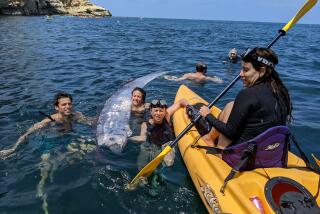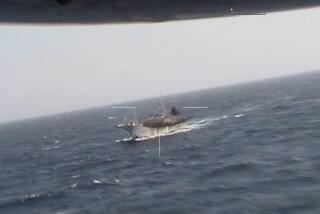Now You See Them. . . : Pursuit of Bluefin Turns From Feast to Famine Aboard San Diego Boat
- Share via
SAN DIEGO — Dawn off northern Baja California. A couple of dozen sportfishing party boats from San Diego have rendezvoused for a bluefin tuna binge, but someone is crashing the party.
“Yesterday was the first day they were here,” says Scott Fronczek, a crewman on the 95-foot Searcher from Fisherman’s Landing. “We saw them making three wraps.”
Fronczek is referring to three commercial purse seiners mingling with the fleet. A wrap is one load of fish hauled aboard in a net. The location is the “213 spot,” a reference to a chart location about 57 miles south of Point Loma and 57 miles west of Ensenada--well inside the 200-mile offshore barrier for foreign commercial fishing mandated by the Mexican government.
Two days earlier, the bluefin catch there was terrific. Several boats had their limits of five per angler by noon--an exciting occurrence because it’s within easy range for one-day trips from San Diego. That’s why the Searcher’s passenger load is up to a nearly full 36 on this day. On the scale of preferred tuna, bluefin is second only to albacore and is especially coveted for the Japanese delicacy sashimi, a dish of thinly sliced raw fish.
But, except for several skipjack tuna, the fishing today is slow. Where have the bluefin gone?
“Into the refrigerated hold of a big steel vessel,” guesses Mike Jones, the Searcher’s skipper, nodding toward a seiner. “We’re thankful we got in three good weeks here. It takes these guys only two or three good nights, and it’s gone.”
Suspicions are that although some of the seiners were Mexican, others were Americans from San Pedro. Those would be remnants of that town’s commercial fishing history now called the “disadvantaged fleet” since the Fisheries Conservation and Management (Magnuson) Act joined the United States with other nations in moving its commercial fishing grounds 200 miles offshore in 1977.
Then, since 1985, when Mexico stopped selling permits for foreigners to fish for tuna within 200 miles of its coastline, it has been tough to make a living.
Said Frank LoPreste, who operates long-range boats from San Diego: “I do know for a fact that there were some American boats there, but there (also) were some Mexican boats there . . . and they definitely took some tuna.”
LoPreste said he knew the identities of the boats, but didn’t want to disclose them. However, American boats seem to be able to fish inside Mexico’s limit with impunity, and the impact on sportfishing can be devastating.
“We could have fished that area for a month,” said Paul Morris, who operates four boats from Fisherman’s Landing.
Bob Fletcher, president of the Sportfishing Assn. of California, said an average sportfishing season will take 600 tons of tuna.
“The entire sportfishing fleet in a season can’t take as much tuna as one purse seiner can take in a day ,” he added.
The Lacey Act allows one government to prosecute violators for poaching in another government’s jurisdiction--as long as the second government also objects. But Gene Proulx, special agent in charge of the National Marine Fisheries Service Office of Enforcement in Long Beach, said when a U.S. Coast Guard plane sighted a tuna purse seiner “engaged in fishing” inside the Mexican limit last year, “when we attempted to enforce the law . . . we got no support from the Mexican government.”
That seems inconsistent with other recent moves by Mexico to protect its resources by restricting the U.S. sportfishing take in its waters. Last year, individual limits on bluefin and yellowfin were slashed to five a day--half the limits for U.S. waters.
“The situation is an odd one,” Proulx said.
Said another NMFS official: “It’s kind of a touchy subject.”
No official of PESCA, Mexico’s authority for fisheries, was available to comment this week. It might be that Mexico is hesitant to press the issue during sensitive negotiations on the North American Free Trade Agreement.
“What scares me more is (a possible repeat) of what happened last year,” LoPreste said, alluding to commercial fishermen taking more fish than they could sell to overworked canneries and dumping the dead surplus back into the sea. “It was horrible . . . pathetic.”
Meanwhile, U.S. commercial fishers apparently have declared war on sportfishers in foreign waters, and as long as Mexico fails to enforce its own law, the odds are in the seiners’ favor. The sportfishers also have electronic equipment to help them find the fish, but the seiners apparently have an air force.
“They had a spotter plane up for them yesterday,” Jones says.
*
By mid-morning, the seiners are gone, their holds apparently full, as the Searcher tries to find what bluefin are left.
Jones commiserates with a colleague on another boat: “We’re fighting a quadruple whammy (in addition to the three seiners). We’ve got a writer from The Times on board, as well.”
Historically, the surest way to turn off a hot bite is to take out a reporter to do a story about it.
Anglers on the Searcher are rotated to troll four or five at a time. At 7:12 a.m., most are in the lounge drinking coffee and cursing the seiners when a yell of “Hookup!” comes from the stern. Jones immediately pulls back the throttles on the twin diesels as the lounge empties in a scramble for rods and positions at the rail.
Someone lands a lone skipjack, but when no other rod bends for the next few minutes, Jones orders all to reel in their lines to move again. The sequence is repeated every 15 or 20 minutes. Each time the call of “Hook-up!” is repeated, fewer anglers stir. They didn’t come out for skipjack.
Later, Jones reports the good news that one of LoPreste’s boats has found a large school of 50-pound bluefin. The bad news is that it’s another 100 miles south.
By midday the sportfishing fleet has scattered, each boat off beyond the horizon, searching on its own, homing in on circling birds and virtually turning over every kelp paddy. Some boats report a few bluefin catches--apparently stragglers from schools that have moved out or been fished out.
“Bluefin get really weird,” LoPreste said this week. “Sometimes they just disappear and you’ll say, ‘What happened?’ Five or six days later they’ll pop up again. To say the seiners caught them all . . . I don’t want to point the gun at somebody when it’s not fair.”
*
Terry Foreman, a marine biologist with the California Department of Fish and Game in Long Beach, is the acknowledged area expert on bluefin tuna, which were the subject of his master’s thesis.
“I’ve talked to people in the industry in San Diego and asked them, ‘Do you remember anything like this?’ and every one of them said no,” Foreman said. “That was an incredible three-week bite, and it’s not over yet.”
The latest reports have the bluefin 70 to 100 miles out of San Diego, stretching the distance for a one-day trip.
“Historically, most of the commercial catch of bluefin has been off Baja,” Foreman said. “For the last 15 years or so, most of the fish have been caught at 29 degrees north (latitude) and above, around Cedros Island (about halfway down the peninsula).
“The bluefin that we catch are spawned in the Sea of Japan or in the western Pacific near Japan. They’ll migrate here as 2- and 3-year-olds.”
Foreman said bluefin mature at 130 to 150 pounds. Since these fish are immature juveniles, they are running from 25 to 60 pounds, still larger than the usual 12 to 25 pounds seen in most years.
Also, whereas yellowfin are more of a tropical tuna, bluefin usually prefer cooler water--from 64 to 68 degrees--although they are being found now in warmer water, Foreman said.
“They’ve also been found in cooler water . . . off Norway,” he added. “They’ll follow the Gulf Stream.”
The only bluefin seen on this day was one Ken Joralemon of Westminster and Brian Zimmer of Port Hueneme pulled from the Searcher’s freezer on the way home, simply to show the others what one looks like. They had caught four the day before.
“I know we didn’t come out to catch skipjack,” Jones tells his customers as he drives the boat back into San Diego Bay. “But at least it kept us alive today.”
But who got the bluefin--the seiners?
“They either got them or broke them up pretty good,” Fletcher said. “They were there two days ago.”
More to Read
Sign up for The Wild
We’ll help you find the best places to hike, bike and run, as well as the perfect silent spots for meditation and yoga.
You may occasionally receive promotional content from the Los Angeles Times.






